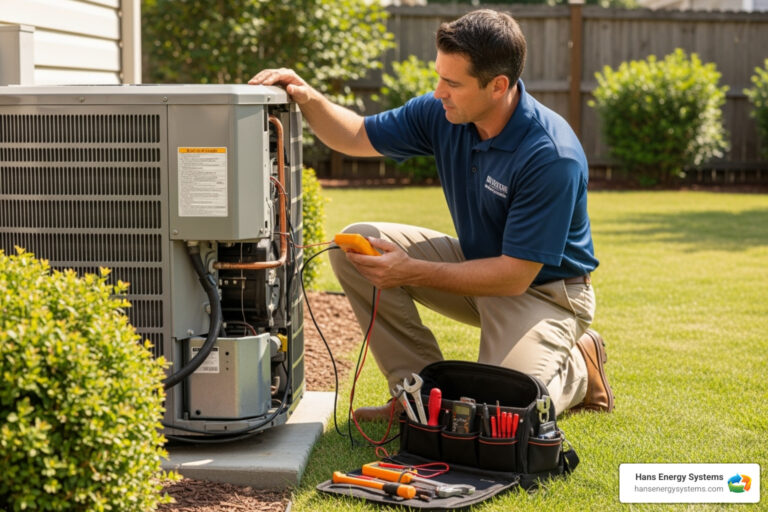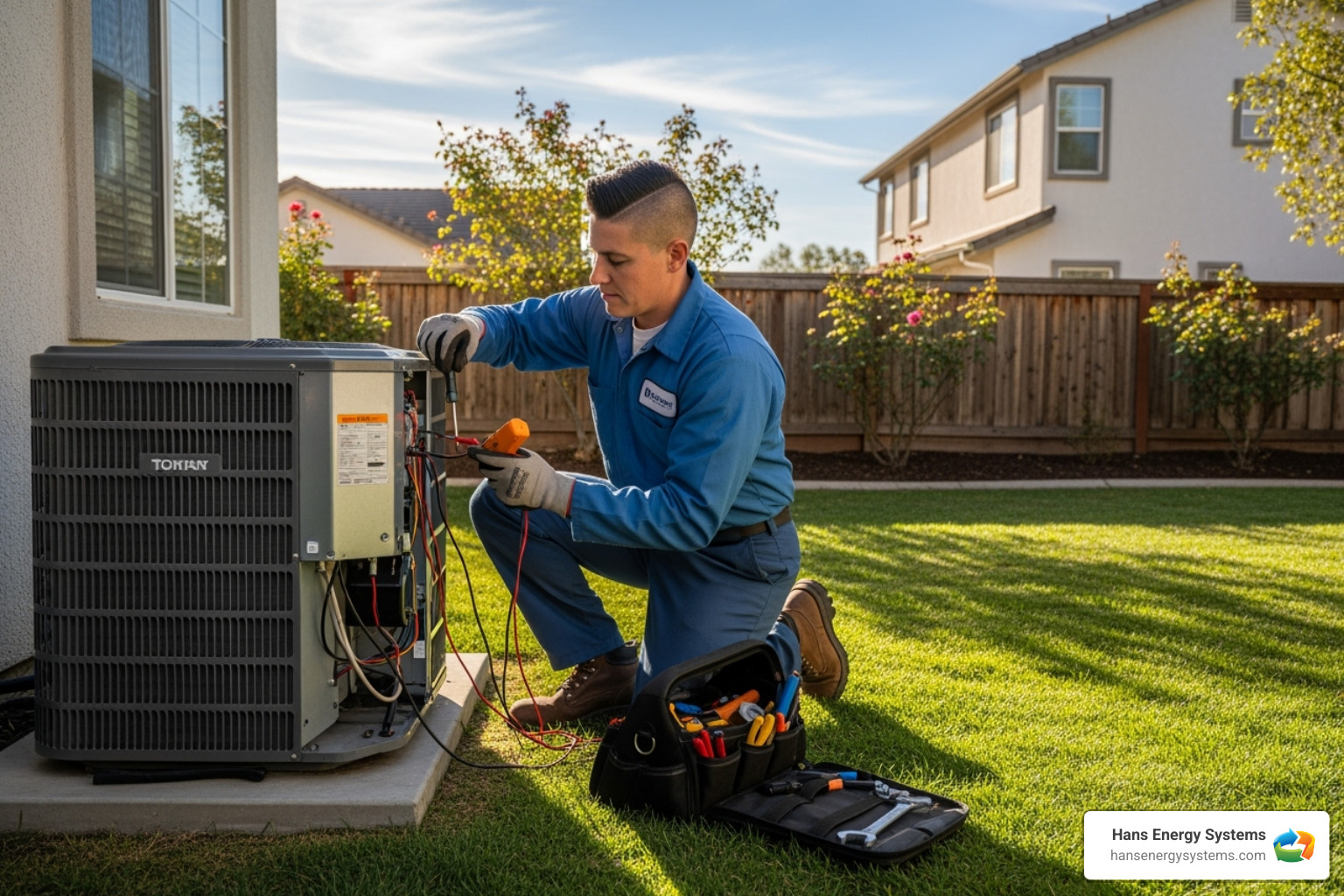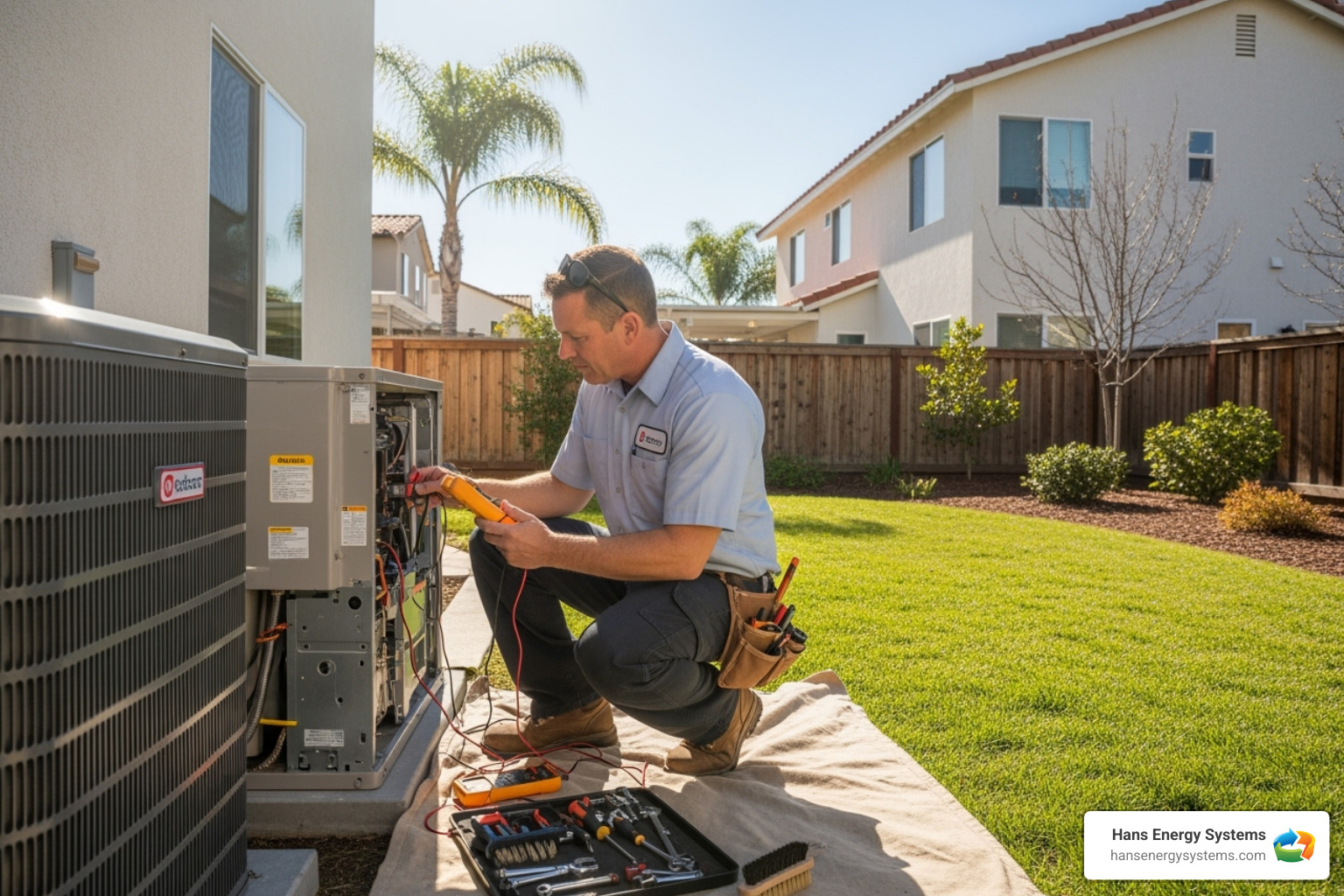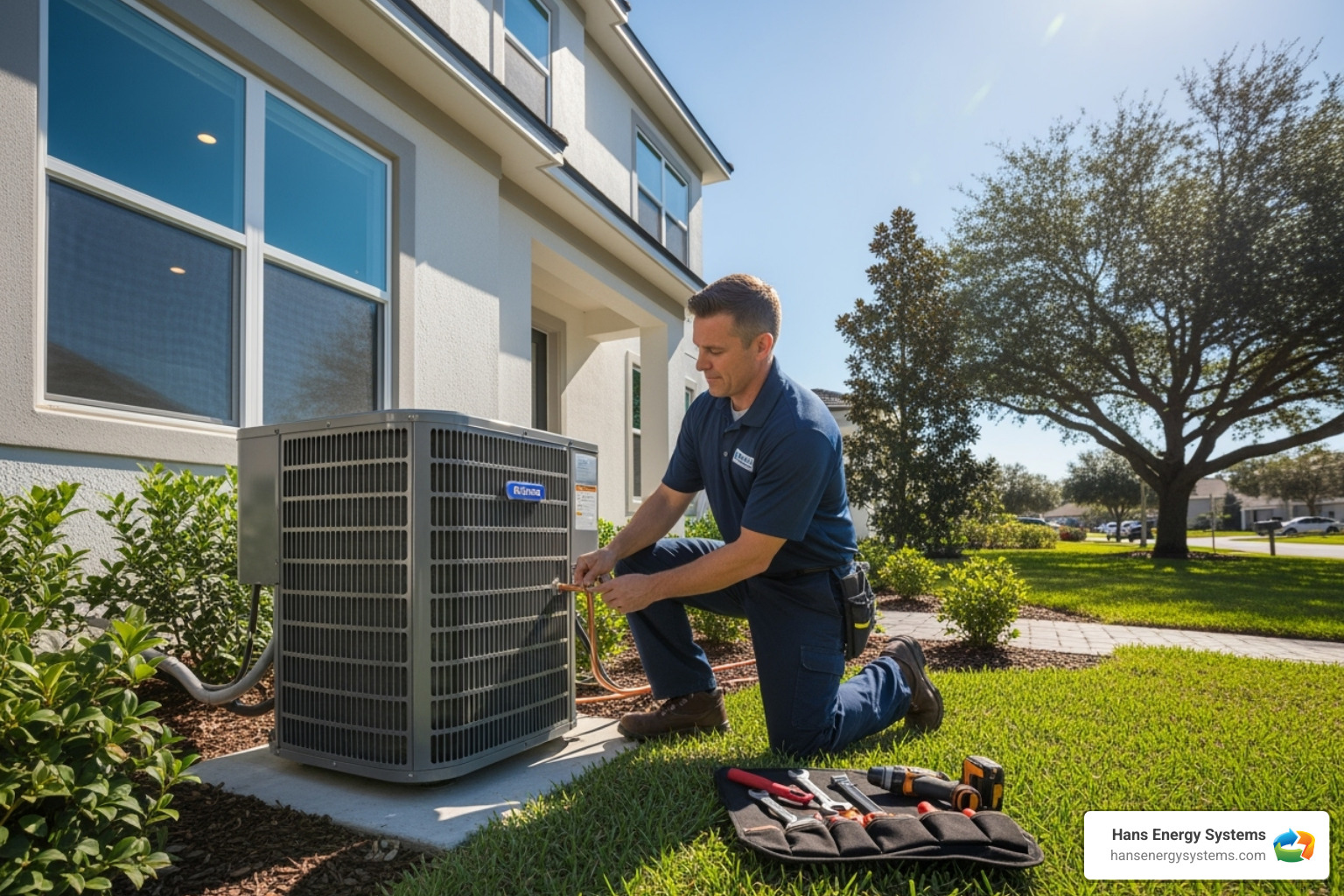Why Your AC System Needs a Proper Check
When your AC system check reveals problems on a sweltering Southern California day, it feels like the worst possible timing. But here’s the thing – most AC issues give you warning signs before they leave you completely without cool air.
Quick AC System Check Overview:
- Thermostat: Set to “Cool” mode, temperature below room temp
- Air Filter: Clean and unobstructed (replace every 1-3 months)
- Circuit Breaker: Not tripped, outdoor unit has power
- Outdoor Unit: Free of debris, condenser coils clean
- Vents: Open and unblocked throughout the home
- Signs of Trouble: Warm air, weak airflow, strange noises, water leaks
Most homeowners can handle basic checks like changing filters and clearing debris. But when you’re dealing with refrigerant leaks, electrical problems, or compressor issues – that’s when you need professional help.
The good news? A systematic approach to diagnosing your AC problems can save you time, money, and the frustration of emergency repairs. Some issues are simple fixes you can handle yourself. Others require the expertise of certified technicians with specialized tools.
Understanding what to check first helps you make smart decisions about when to DIY and when to call for professional service. After all, running your AC with serious problems can turn a minor repair into an expensive replacement.
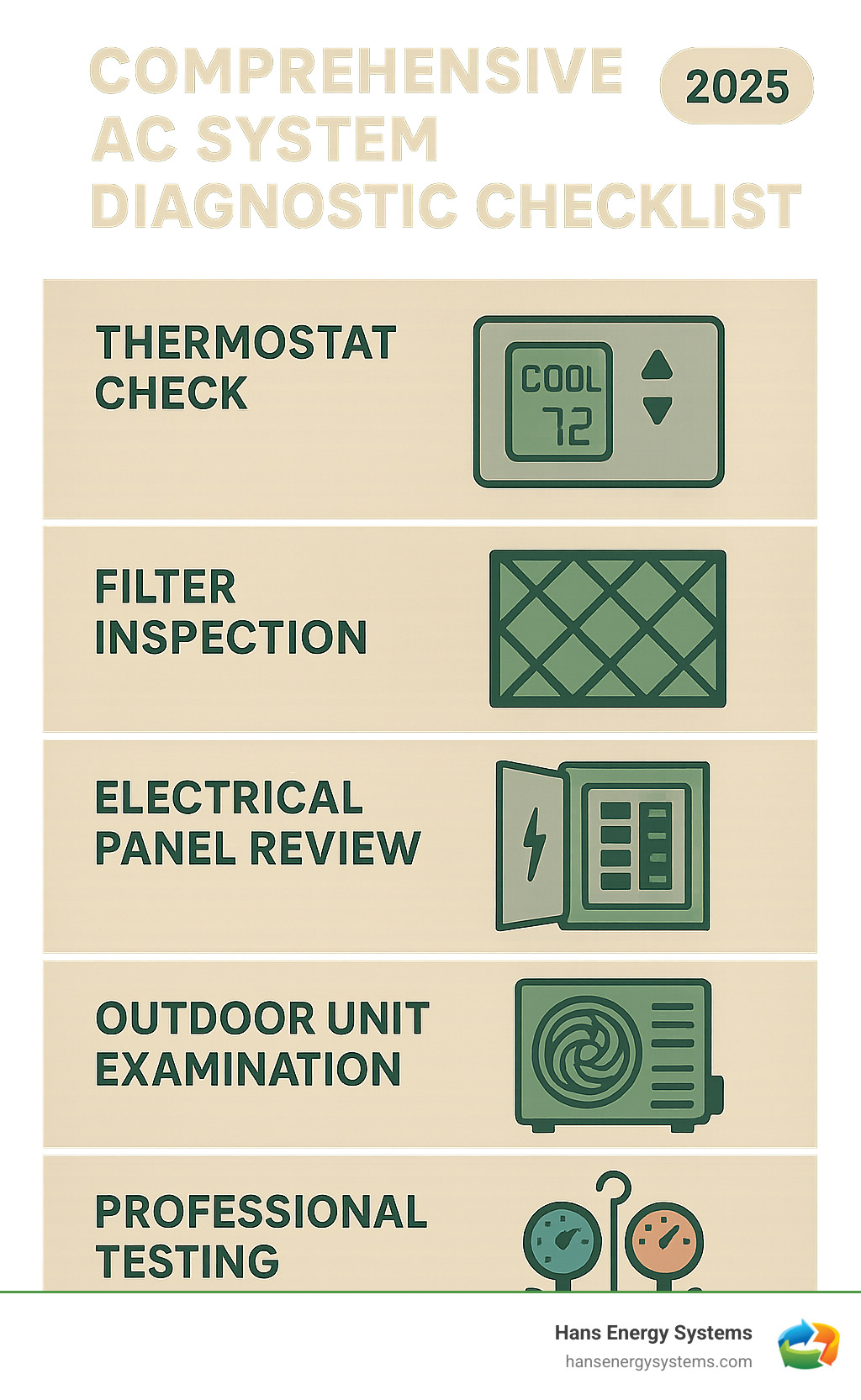
First Steps: Simple DIY Checks Before You Call for Help
Look, we get it – when your AC stops working on a blazing hot day, panic mode kicks in. But before you reach for the phone, take a deep breath. There are several straightforward AC system check steps that might solve your problem right away, saving you time and money on a service call.
Even if these checks don’t completely fix the issue, they’ll give our technicians valuable clues about what’s going wrong. Think of it as detective work – every piece of information helps us diagnose the problem faster when we arrive at your Poway home.
Check Your Thermostat
Here’s something that might make you chuckle (or cringe): we’ve responded to countless “emergency” calls where the thermostat was simply set wrong. It happens to the best of us!
Start with the basics. Make sure your thermostat is set to “Cool” mode, not “Heat” or “Fan Only.” After a mild San Diego winter, it’s surprisingly easy to forget to switch modes when the first heat wave hits.
Set the temperature a few degrees lower than your current room temperature and wait a few minutes. If nothing happens, check the batteries – yes, even fancy digital thermostats need fresh batteries to work properly. Dead or low batteries can cause all sorts of confusing behavior.
Smart thermostat acting up? Check if it’s still connected to your Wi-Fi network. Sometimes a simple restart fixes programming glitches or connection issues. Also, make sure your thermostat isn’t getting fooled by direct sunlight or heat from nearby lamps – that can throw off its temperature readings completely.
Inspect the Air Filter and Vents
Here’s the truth: a dirty air filter is behind more AC problems than you’d believe. Think of your AC trying to breathe through a dust-caked filter – it’s like running a marathon while breathing through a straw.
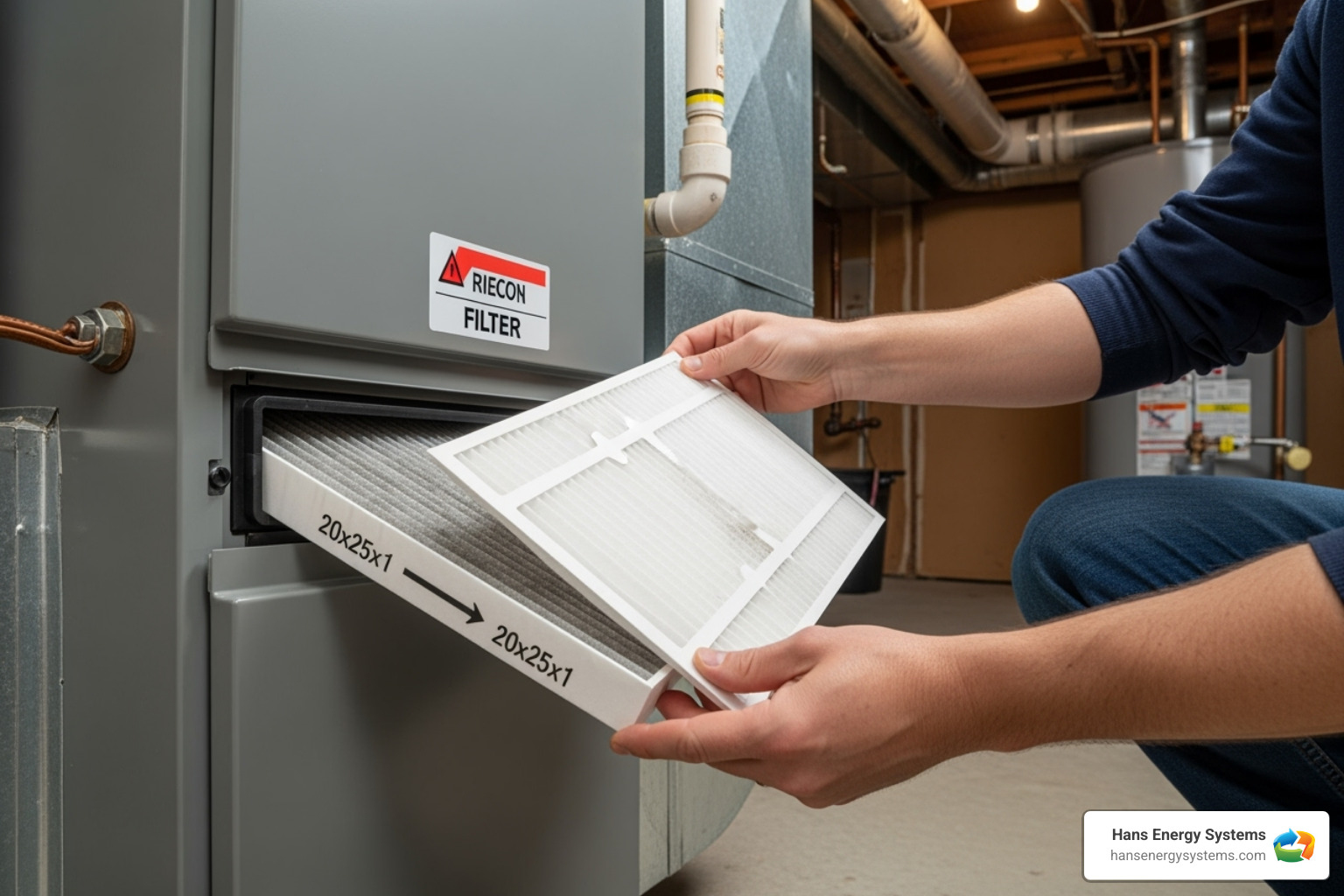
Pull out your filter and hold it up to the light. If you can’t see through it clearly, it’s time for a replacement. We recommend changing filters every one to three months, especially if you have pets or family members with allergies.
While you’re at it, take a walk through your house and check every air vent. Are they all open and unobstructed? That couch pushed against a vent or curtains draped over a register can seriously mess with your system’s airflow.
Here’s a money-saving tip: don’t close vents in unused rooms thinking you’ll save energy. Closing vents in your home can cause damage to your air conditioning unit by creating pressure imbalances that strain your system and can lead to expensive repairs.
Look at Your Breakers and Outdoor Unit
Sometimes the simplest solutions are hiding in plain sight. If your AC won’t turn on at all, head to your electrical panel and look for tripped breakers. A tripped breaker looks different from the others – it’ll be in the middle position or flipped to “off.”
Reset it by flipping it fully off, then back on. If it trips again immediately, stop – that’s a sign of a serious electrical problem that needs professional attention.
Don’t forget to check for a power switch near your outdoor unit. We’ve seen these accidentally switched off by gardeners, kids playing outside, or even homeowners who forgot they turned it off during winter.
Now for the outdoor detective work. Your condenser unit (that big box outside) needs to breathe freely to do its job. Walk around it and clear away any leaves, dirt, or debris that’s built up around the sides. Even grass clippings can block airflow and make your system work harder.
The metal fins on your condenser can get pretty grimy over time. If they look dirty, you can gently rinse them with a garden hose – just make sure to turn off the power first. Be gentle though; those fins bend easily, and bent fins reduce efficiency.
For more detailed information about tackling these and other issues, check out our guide on common AC problems and solutions.
Decoding the Symptoms: Common AC Problems and Their Causes
Once you’ve completed the initial DIY checks, it’s time to become a detective and link the symptoms you’re experiencing to potential root causes. Think of your AC system check as solving a puzzle – each symptom tells a story about what’s happening inside your system. Understanding these common AC problems helps you know when you can handle things yourself and when it’s time to call us for professional AC repair in Poway.
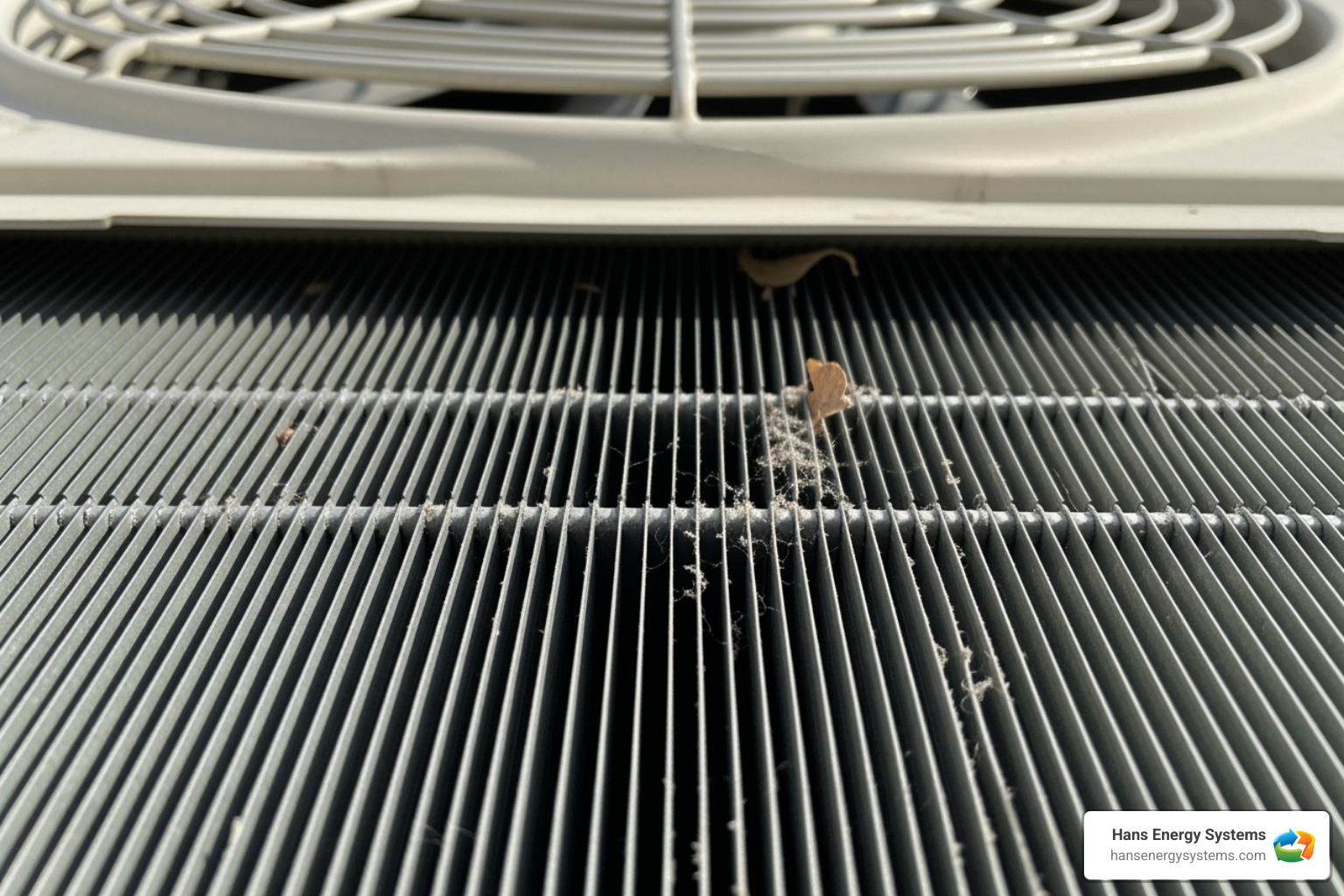
Symptom: AC Blows Warm or Lukewarm Air
This is the most frustrating symptom on a scorching San Diego day. When your AC is running but the air coming out feels more like a gentle spring breeze than Arctic relief, several things could be happening behind the scenes.
Low refrigerant levels are often the main culprit. Refrigerant is your AC’s secret weapon – it absorbs heat from inside your home and dumps it outside. When refrigerant runs low, your system can’t absorb enough heat to cool your air properly. Here’s the thing: refrigerant doesn’t just disappear over time like gas in your car. If it’s low, you almost certainly have a leak somewhere in the system.
Dirty condenser coils on your outdoor unit can also cause warm air problems. These coils need to release heat to the outside air, but when they’re caked with dirt, leaves, and grime, they can’t do their job effectively. It’s like trying to cool down while wearing a heavy winter coat.
Your evaporator coil inside the house can get dirty too, making it harder to absorb heat from your indoor air. When either coil is dirty, your system works harder but accomplishes less.
Sometimes the problem is more serious – compressor failure. The compressor is basically the heart of your AC system, pumping refrigerant through all those coils. When it starts failing, you might hear unusual buzzing sounds along with that disappointing warm air. If you’re hearing strange noises from your unit, our guide on Why Your AC Unit Makes Buzzing Sounds can help you understand what’s happening.
Symptom: Weak Airflow from Vents
When you hold your hand up to a vent and barely feel a whisper of air, even if that air is cool, you’re dealing with airflow restrictions. This symptom can be just as uncomfortable as warm air because your home never quite reaches the temperature you want.
The clogged air filter we talked about earlier is usually suspect number one. When that filter gets packed with dust, pet hair, and debris, it’s like trying to breathe through a thick blanket. Your system simply can’t push enough air through to cool your home effectively.
Blower motor problems can also cause weak airflow. This motor is responsible for pushing all that conditioned air through your ducts and out your vents. When it starts struggling or failing, you’ll notice the difference immediately in how much air reaches each room.
Your home’s ductwork might be the problem too. Ducts can develop leaks over time, especially at joints and connections. When this happens, your precious cool air escapes into your attic or crawl space instead of reaching your living areas. Sometimes ducts get blocked by debris or even small animals looking for a cozy place to nest.
A frozen evaporator coil creates a double problem – it can’t absorb heat properly, and the ice buildup blocks airflow. This usually happens when there’s already restricted airflow (like from a dirty filter) or when refrigerant levels are low. The coil gets too cold, moisture freezes on it, and suddenly you have an ice block where you need heat exchange.
Symptom: Unit is Leaking Water or Frosting Up
Water where it shouldn’t be, or ice forming on your AC lines, are clear signs something’s not right with your system. These symptoms might look different, but they’re often related to the same underlying issues.
A clogged condensate drain line is a common cause of water leaks. Your AC naturally removes humidity from your indoor air – that’s part of how it cools your home. This moisture normally drains away harmlessly through a small line. But when algae, mold, or debris clogs this drain, water backs up and can overflow into your home. If water is leaking from your air conditioning unit into your home, turn it off immediately to avoid costly water damage.
Low refrigerant can cause your evaporator coil to get too cold and freeze up. When this ice melts, you get water leaks. You might also notice frost or ice building up on the refrigerant lines themselves, especially the larger insulated line that runs to your outdoor unit.
Ice buildup isn’t just a winter problem. When your AC system can’t maintain proper temperatures and pressures due to airflow problems or refrigerant issues, ice can form even on hot summer days. This ice prevents your system from working properly and can cause water damage when it melts.
Symptom: System is Short-Cycling or Making Strange Noises
An AC that constantly turns on and off, or sounds like it’s auditioning for a horror movie soundtrack, is trying to tell you something important. These symptoms often indicate more complex problems that need professional attention.
Short-cycling happens when your system runs for just a few minutes, shuts off, then starts up again shortly after. While it might seem like your AC is working hard to keep you cool, it’s actually working inefficiently and wearing itself out. Sometimes this happens because the unit is oversized for your home – it cools the space too quickly, thinks the job is done, then realizes it needs to start again when the temperature creeps up.
Electrical problems can cause both short-cycling and strange noises. Issues with capacitors, contactors, or wiring can prevent your system from starting properly or staying running smoothly. You might hear clicking, buzzing, or humming sounds as electrical components struggle to do their jobs.
Failing components often announce themselves with distinctive sounds. Rattling might mean a loose fan blade or debris in the unit. Grinding or squealing usually indicates motor bearings that need attention. Banging sounds are never good – they often mean something has broken loose inside the unit.
These mechanical problems rarely fix themselves, and ignoring them usually leads to more expensive repairs down the road. If your system has started short-cycling frequently, our article on When AC Starts Short Cycling in Poway provides more detailed information about causes and solutions.
The key to a successful AC system check is understanding that symptoms rarely occur in isolation. Weak airflow might lead to frozen coils, which can cause water leaks and strange noises. Low refrigerant might cause warm air, short-cycling, and ice formation. That’s why professional diagnosis is so valuable – we can trace these interconnected problems back to their root causes and fix them properly the first time.
The Importance of a Professional AC System Check
While those DIY checks we talked about are fantastic first steps, there’s a point where even the handiest homeowner needs to step back and call in the cavalry. If you’ve worked through our troubleshooting guide and your AC is still giving you grief, or if you suspect something more serious like refrigerant leaks or electrical gremlins, it’s time to bring in professional help.
Here’s the thing – some AC problems aren’t just tricky to fix; they can be downright dangerous to tackle yourself. Take refrigerant, for example. This stuff requires specialized equipment and know-how because of its chemical properties and environmental impact. In fact, under U.S. law, only certified technicians may handle refrigerants—see the EPA’s Section 608 requirements for details. Those DIY AC recharge kits you see at the store? They might seem like a quick fix, but they can actually contaminate your system or damage your compressor, potentially making future professional repairs impossible.
The refrigerant charge needs to be just right – too little and your AC won’t cool properly, too much and you could damage the compressor. If your system has leaked all its refrigerant, it likely contains air and moisture that require proper evacuation and a new dryer to prevent contamination. This isn’t weekend warrior territory.
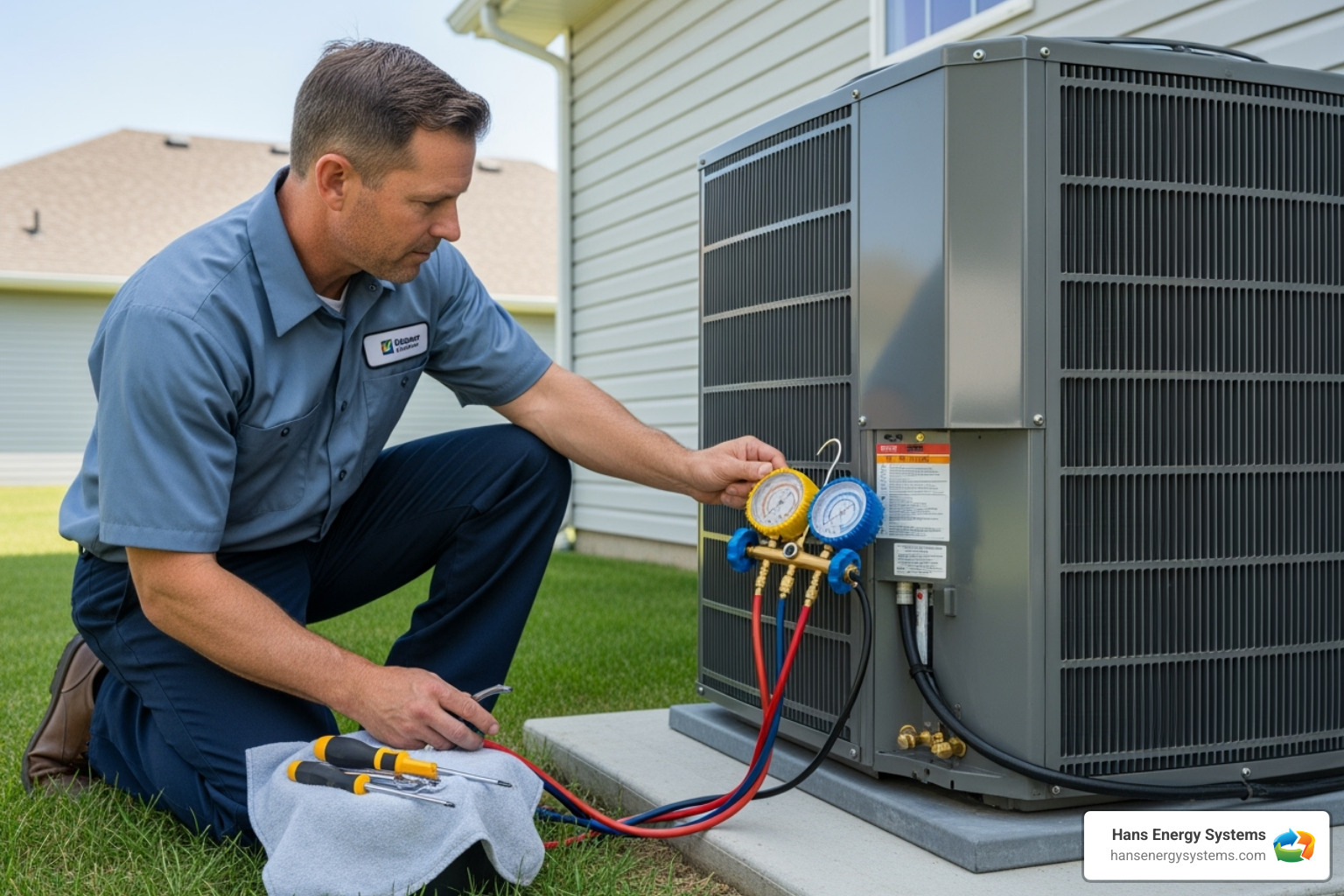
What’s Included in a Professional AC System Check?
When our certified technicians at Hans Energy Systems perform a professional AC system check in your Poway home, we’re doing way more than just kicking the tires and checking the oil. Our comprehensive inspection digs deep to find problems before they find you.
Our refrigerant pressure check and leak detection goes beyond simply topping off low levels. We use specialized gauges to get precise pressure readings, then employ advanced detection methods to hunt down any leaks. If we find one, we don’t just patch it up – we repair it properly and ensure your system is sealed tight before recharging.
Electrical connections get the full treatment too. We inspect and tighten all connections to prevent hazards and ensure smooth operation. Every key component – your compressor, fan motors, capacitors, and contactors – gets tested to make sure they’re performing within manufacturer specifications.
Coil cleaning is where we really shine. We thoroughly clean both your indoor evaporator coil and outdoor condenser coils. Clean coils are essential for efficient heat transfer, and dirty ones can cost you big time in energy bills.
We also flush your condensate drain line to clear any clogs and prevent future water leaks and potential mold growth. Nobody wants that surprise puddle or musty smell creeping into their home.
Of course, we’ll confirm your air filter is clean and properly installed, replacing it if needed. Then we wrap up with an overall system evaluation, checking airflow, temperature differential, and listening for any unusual noises or vibrations that might signal trouble ahead.
Our Comprehensive AC Unit Inspection Checklist guides our technicians through every step, ensuring nothing gets missed. And if you want to stay ahead of the game, ask us about our HVAC Maintenance Plan Poway, CA for regular, hassle-free professional checks.
Why a Regular AC System Check is Crucial for Your Home
Think of regular AC system check services as insurance for your comfort and your wallet. The benefits go way beyond just keeping cool.
Your energy bills will thank you when your AC runs efficiently. A well-maintained system doesn’t have to work as hard to cool your home, which means it uses less energy. Those savings add up quickly, especially during our hot San Diego County summers.
Your system will live longer too. Regular maintenance catches those small issues before they turn into expensive disasters. By keeping components clean and properly adjusted, we can significantly extend your AC’s operational life. Modern units are built to last for decades with proper care – but the key phrase is “with proper care.”
The air you breathe gets better when your system is clean. Clean coils and filters mean cleaner air circulating through your home, free from dust, allergens, and mold spores. Your family’s health is worth that investment.
Prevention beats emergency repairs every time. There’s nothing worse than your AC dying on the hottest day of the year. Our proactive inspections identify worn parts or potential failures before they leave you sweating and scrambling for emergency service.
Most importantly, you get peace of mind. Knowing your AC system has been professionally inspected and is running optimally lets you sleep soundly, even during those scorching summer nights that San Diego County is famous for.
Frequently Asked Questions about AC Diagnostics
After years of helping homeowners in Poway and across San Diego County with their cooling troubles, we’ve heard just about every AC question imaginable. Here are the ones that come up most often, along with honest answers from our experience in the field.
How often should I have my AC inspected?
The short answer? Once a year, every year. We always tell our customers that the best time for your annual AC system check is in spring, before San Diego’s heat really kicks in. Think of it like getting your car serviced before a long road trip – you want to catch any issues before you’re depending on it most.
Spring timing isn’t just convenient; it’s strategic. Your AC has been sitting mostly idle through our mild winters, and you want to make sure everything’s ready for the marathon of summer cooling ahead. An annual inspection helps prevent those dreaded breakdowns on the hottest days and keeps your system running efficiently when you need it most.
We’ve seen too many families sweltering in July because they skipped their spring tune-up. Trust us, it’s much better to address potential problems when the weather’s still pleasant than to find them during a heatwave.
Is it bad to close vents in unused rooms?
This is one of those things that seems to make perfect sense but actually backfires. Yes, closing vents in unused rooms can damage your air conditioning unit. We get it – the logic seems sound. If you’re not using the guest room, why waste cool air there?
Here’s the problem: your AC system was designed with all those vents in mind. When you start closing them off, you’re disrupting the carefully balanced airflow that keeps everything running smoothly. Closing vents in your home can cause damage to your air conditioning unit by increasing pressure in your ductwork.
Think of it like pinching a garden hose while the water’s running. That extra pressure has to go somewhere, and it often leads to air leaks in other parts of your duct system. Your AC ends up working harder, not easier, and you might end up with higher energy bills instead of lower ones.
The best approach? Keep all your vents open and let your system work as it was designed.
What are the signs my AC unit needs to be replaced?
Nobody wants to hear that their AC needs replacing, especially when it still turns on and blows some cool air. But sometimes, holding onto an old unit costs more in the long run than investing in a new one.
Age is the biggest factor. Most residential AC units give you good service for about 10 to 15 years. After that, they start becoming less reliable and much less efficient. If your unit is pushing into its second decade, it’s worth having an honest conversation about replacement.
Frequent repairs are another red flag. We have a rule of thumb: if repair costs are approaching half the price of a new unit, or if we’re visiting your home multiple times each cooling season, replacement usually makes more financial sense.
Your energy bills can tell a story too. Older units are energy hogs compared to modern systems. If your cooling costs keep climbing even though your usage habits haven’t changed, your aging AC might be the culprit.
There’s also the refrigerant issue. If your system uses R-22 refrigerant (sometimes called “Freon”), you’re running on borrowed time. This refrigerant is being phased out by the EPA, making it expensive and increasingly difficult to find when you need repairs.
Finally, pay attention to inconsistent temperatures throughout your home. If some rooms feel like saunas while others are comfortable, even with all vents open, your AC may no longer have the capacity to properly cool your entire home.
When you start noticing these warning signs, it might be time to explore your options. Our detailed guide on Signs Your Home is Ready for New AC Installation can help you make an informed decision about whether to repair or replace.
Your Next Step for a Cool and Comfortable Home
We hope this guide has given you the confidence to tackle a basic AC system check on your own. There’s something satisfying about solving a problem yourself – like finding your AC wasn’t cooling simply because someone accidentally switched the thermostat to “heat” mode!
But let’s be honest about the limits of DIY repairs. While you can handle the basics like changing filters and clearing debris, some problems require professional expertise. Refrigerant leaks need specialized equipment to detect and repair safely. Complex electrical issues can be dangerous if you don’t know what you’re doing. And trying to diagnose internal component failures without the right tools is like trying to perform surgery with a butter knife.
We’ve seen well-meaning homeowners turn minor repairs into major headaches by attempting fixes beyond their skill level. What starts as a simple refrigerant top-off can end up contaminating the entire system, leading to expensive compressor replacement. That’s why knowing when to call for help is just as important as knowing what to check first.
At Hans Energy Systems, we understand that your comfort is our priority. Our experienced technicians have seen every AC problem imaginable across San Diego County, from the simple fixes to the truly puzzling cases that require detective work. We bring the right tools, expertise, and genuine care for getting your system running smoothly again.
The best part? You don’t have to wait until your AC completely gives up on you. Proactive maintenance and timely professional intervention keep your system healthy and your home comfortable year-round. Think of it as taking your car in for regular oil changes – a little attention now prevents big problems later.
Ready to ensure your AC keeps you cool through whatever weather comes your way? Schedule your professional AC repair in Poway today with Hans Energy Systems. We’re here to help you stay comfortable, no matter how hot it gets outside!


